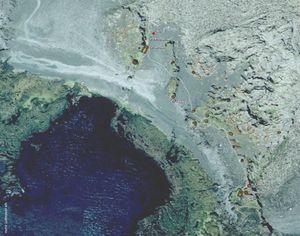Selatangar

Verstöð á Selatöngum
Á Selatöngum er að finna minjar um verbúðir, fiskbyrgi og fiskigarða. Rústirnar eru um 20 en auk þeirra eru á svæðinu fjöldi fiskigarða. Í öðru bindi bókarinnar Íslenskir sjávarhættir lýsir Lúðvík Kristjánsson verbúðatóft á Selatöngum: „Dyr hafa verið á gaflinum, sem snýr til sjávar. Inn af þeim hafa verið rösklega þriggja álna löng göng og er þá komið þar í búðina, sem bálkarnir hafa verið, en bilið á milli þeirra er um 1 m. Bálkarnir eru næstum 4 m á lengd en dálítið misbreiðir, annar um 1,3 m, en hinn um 1 m, og kann það að stafa af missigi. Búð þessi hefur rúmað átta menn. Í framhaldi af rýminu á milli bálkanna eru rúmlega 1,2 m löng göng yfir í lítið hýsi, sem hefur verið eldhús um 2 m á breidd. Hlóðirnar hafa verið hægra megin þegar inn er komið...“
Lífið í verbúðunum var mótað af aldagömlum siðum og hefðum. Menn skiptu með sér verkum. Sækja þurfti vatn og eldivið, elda mat o.s.frv. Í sumum verbúðum voru ýmis embætti eins og embætti kjásarhaldara. Hann sá um að tæma kjásarhaldið, kerald sem í var næturgagn búverja.
Menn þurftu stundum að vera í landi vegna ógæfta. Þá sinntu þeir ýmsum störfum. Á Selatöngum eru nokkrir hraunhellar sem notaðir voru til ýmissa verka. Nöfn þeirra segja til um notkunina. Í einum var kvörn og var hann kallaður Mölunarkór. Í öðrum var sagað og kallaðist hann Sögunarkór. Sá þriðji hét Smíðahellir.
Fiskverkunin fólst fyrst og fremst í því að þurrka fiskinn. Fiskurinn var breiddur á garða eða möl og roðið ætíð látið snúa niður á daginn en upp að næturlagi. Sums staðar var fiskur þurrkaður í grjótbyrgjum eins og þeim sem eru á Selatöngum. Birgin voru einnig notuð til að geyma fullharðnaðan fisk.
Til að gæta öryggis er gestum bent á að fylgja ráðlagðri leið um svæðið, sjá myndina hér til hliðar. Svæðið utan gönguleiðarinnar getur verið varhugavert yfirferðar – sleipt fjörugrjót við sjóinn og úfið hraun inn til landsins. Athugið að víða á gönguleiðinni eru ójöfnur.
Gangið um minjarnar af virðingu, klifrið ekki í hleðslum eða hróflið við þeim á nokkurn hátt.
Fishing Station at Selatangar
The ruins of fishermen's huts, fish storage huts and stone walls can be found at Selatangar. There are approximately 20 remains in the area, along with a number of stone walls. In the second volume of Fishing in Iceland, Lúðvík Kristjánsson describes the ruins of a fisherman's hut at Selatangar: “There were doors on the gable facing the sea. Within, there would have been a tunnel, just over three ells in length, leading to the hut where the sleeping partitions were, with approximately 1 m between them. The partitions are almost 4 m in length, but the width is different; one is approximately 1.3 m, and the other is approximately 1 m, perhaps due to varying subsidence. The hut would have housed eight men. Beyond the space between the partitions, a 1.2 m tunnel leads to a small cot, 2 m in width, which was used as a kitchen. The fireplace would have been on the right when one entered...”
Life in the fishermen's huts was shaped by centuries of customs and traditions. The men allocated tasks among themselves. Water and firewood had to be fetched, food cooked, etc. Some fishermen's huts had offices such as that of “pot officer”, whose job it was to empty the chamber pots of the residents.
When the men had to stay on land due to bad weather, they tended to various tasks and used some of the lava caves in Selatangar for their purposes. The names of the caves indicate their use. One was named after the grinding mill kept in it, another was named after the practice of sawing wood in it and the third was named after its use as a workshop.
Fish was most often processed by drying. The fish was spread out on walls or gravel, with the fishskin facing down during the day and up during the night. In some places, the fish was dried in rock shelters like the ones in Selatangar. They were also used to store fully dried fish.
Due to safety concerns, visitors are advised to follow the marked paths in the area; see the accompanying illustration. Areas outside the paths can be difficult to traverse, with slippery rocks by the sea and rough lava inland. Note that many parts of the walking path are uneven.
Treat the remains respectfully, and do not climb walls or disturb them in any way.
